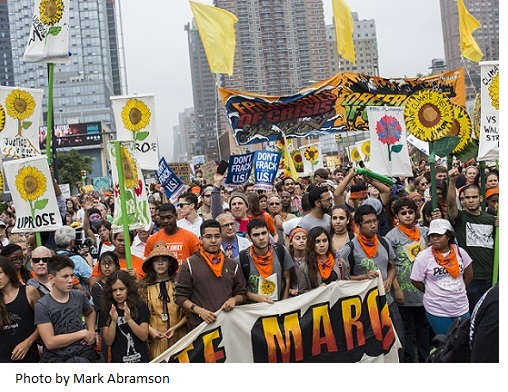
September 21st was written into history when, according to the organizers, approximately 400,000 people marched on the streets of Manhattan in what was called the People’s Climate March, the biggest mobilization around climate change in history.
“We said it would take everyone to change everything — and everyone showed up,” said Eddie Bautista, the Executive Director of the New York City Environmental Justice Alliance. Bautista was on the frontline of Sunday’s massive climate march, which started off at Central Park, the same place where the first Earth Day was held on April 22nd, 1970.
Before the march Bill McKibben, co-founder of 350.org, a network building a global climate movement, and one of the initiators to the mobilization, wrote in an email to Toward Freedom: ”We expect a huge throng of people in the streets, demonstrating to leaders that they best take this issue seriously. By itself it will accomplish little; the daily grind of organizing will continue. But occasionally you have to show the world how big the movement is.”
Indeed, they did send a message to the world’s political and economic elite who were gathering at a UN summit on Climate Change just a couple of days following the march.
The People’s Climate March was led by communities and indigenous people who are on the frontlines of the fight against climate change. There was a rich diversity among participants, including people from around the world and activists all ages and classes. Several world leaders also attended the march to show their support. In the crowd you could catch a glimpse of New York City’s Mayor Bill de Blasio, ex Vice President Al Gore, UN Secretary-General Ban Ki-moon and Leonardo DiCaprio, who recently was designated as UN Messenger of Peace with special focus on climate change.
Yudith Nieto, climate justice activist from Houston, Texas said, after several hours of marching in the streets, ”I am really overwhelmed by seeing so many people from frontline communities, who actually find themselves in the frontline of facing the negative effects of the climate crisis, represented here.”
Like several other participants, Nieto underlined the fact that after the march, people would return home with the feeling that they are not alone in their struggle.
In spite of the enormous challenges the climate movement is facing, it was indeed a hopeful march.
”Change is possible if people get to gather and start to ask for things. If we can mobilize enough people this change could come. The fossil fuel [industry] only has money,” Bill McKibben told Democracy Now! on the morning of the march.
The question is, will people continue the fight to make a change. Author Naomi Klein, who recently published her new book, This Changes Everything: Capitalism vs. The Climate argues that if the climate movement can gather masses of people and change public opinion, it becomes harder for politicians to ignore the movement and continue clinging to the fossil fuel industry. In thise sense, with pressure from below, the urgency of the climate crisis can lead to radical change.
Ban Ki-moon and many other world leaders agree about the seriousness of climate change, but they typically differ from the grassroots of the climate justice movement in how to bring about much-needed changes.
The aim of last week’s UN Climate Summit was to push forward transformative action ahead of next year’s Climate Summit in Paris in order to reach a globally-significant climate agreement. Leaders at the UN meeting in New York promised to mobilize financial resources for investments in renewable energy, energy efficiency and reducing pollution.
But as Naomi Klein explains in her book, climate crises have reached a critical point at the same time that world politics and dominant ideologies have shifted toward neoliberal policies which destroy the very social welfare programs and infrastucture needed to help people weather climate change.
Yet there is still reason to hope. Last week, the UN also hosted the first World Conference on Indigenous People in which indigenous groups from around the world participated on equal terms with heads of states. The main theme for the conference related to indigenous people’s right to land and water in the light of international conventions. The gathering was a step forward in the long struggle for global indigenous rights.
Indigenous people not only bear the brunt of climate crises worldwide, according to Naomi Klein, they also put forth many solutions for overcoming it. In her book, Klein points to the ways in which various indigenous groups around the world have advocated alternatives to capitalism and the related climate crises that focus on respecting Mother Eath, and managing natural resources for the common good.
According to McKibben, one of the core issue with climate change is that ”we’re burning so much coal and gas and oil that we’re raising the temperature of the planet. So we’ve got to stop doing that and find something else to power our lives. Given the way that political and economic power is distributed in this world, that is a harder task than it should be.”
Christin Sandberg is a Swedish journalist based in Guatemala. Christin follows human rights, indigenous and feminist grassroots movements and is interested in all kinds of expressions, such as art, politics and social movements that can induce social change in society. Christin believes in diversity, equity and justice. For more writing go to: http://christinsandberg.wordpress.com
